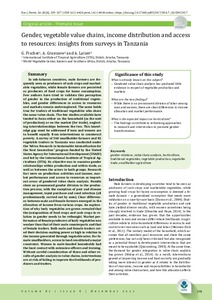| dc.contributor.author | Fischer, G. |
| dc.contributor.author | Gramzow, A. |
| dc.contributor.author | Laizer, A. |
| dc.date.accessioned | 2019-12-04T11:14:10Z |
| dc.date.available | 2019-12-04T11:14:10Z |
| dc.date.issued | 2017-12-29 |
| dc.identifier.citation | Fischer, G., Gramzow, A. & Laizer, A. (2017). Gender, vegetable value chains, income distribution and access to resources: insights from surveys in Tanzania. European Journal of Horticultural Science, 82(6), 319-327. |
| dc.identifier.issn | 1611-4426 |
| dc.identifier.uri | https://hdl.handle.net/20.500.12478/2674 |
| dc.description.abstract | In sub-Saharan countries, male farmers are frequently seen as producers of cash crops and marketable vegetables, while female farmers are perceived as producers of food crops for home consumption. Few authors have tried to validate this perception of gender in the production of traditional vegetables, and gender differences in access to resources and markets remain underexplored. The same holds true for traders of traditional vegetables who share the same value chain. The few studies available have tended to focus either on the household (as the unit of production) or on the market (for trade), neglecting interrelationships between the two. This knowledge gap must be addressed if men and women are to benefit equally from interventions to counteract poverty. A survey of 360 smallholder farmers and 82 vegetable traders in Tanzania was conducted under the “Africa Research in Sustainable Intensification for the Next Generation” program funded by the United States Agency for International Development (USAID) and led by the International Institute of Tropical Agriculture (IITA). Its objective was to examine gender relationships within production and within trade, as well as between the actors in both groups. Research foci were on production activities and income, market performance and access to resources as important areas of gendered value chain analysis. Results show no pronounced gender division in the production process, with the exception of pest and disease management, input purchase and seed selection (all predominantly carried out by men). Clear differences between male and female farmers emerged in the allocation of income from various crops. An exploration of why leafy vegetables are grown revealed that the juxtaposition of food crops and cash crops in relation to gender needs to be rethought. Market performance of female producers of leafy vegetables was weaker than that of their male counterparts and that of female traders. Both male and female traders rated their decision-making power as high in relation to the income generated through vegetable sales. For female smallholders, access to land constituted a major constraint. Women in male-headed households had the least contact with extension officers and training. Without careful consideration of these and other results of gender analysis in value chains, interventions are at risk of failing to improve the livelihoods of producers and traders. |
| dc.format.extent | 319-327 |
| dc.language.iso | en |
| dc.subject | Gender Analysis |
| dc.subject | Value Chain |
| dc.subject | Horticulture |
| dc.subject | Agriculture |
| dc.subject | Vegetables |
| dc.subject | Income Distribution |
| dc.subject | Access To Resources |
| dc.subject | Value Chain |
| dc.title | Gender, vegetable value chains, income distribution and access to resources: insights from surveys in Tanzania |
| dc.type | Journal Article |
| dc.description.version | Peer Review |
| cg.contributor.affiliation | International Institute of Tropical Agriculture |
| cg.contributor.affiliation | World Vegetable Center |
| cg.coverage.region | East Africa |
| cg.coverage.country | Tanzania |
| cg.creator.identifier | Gundula Fischer: 0000-0002-7658-786X |
| cg.isijournal | ISI Journal |
| cg.authorship.types | CGIAR multi-centre |
| cg.iitasubject | Gender |
| cg.iitasubject | Plant Production |
| cg.iitasubject | Value Chains |
| cg.journal | European Journal of Horticultural Science |
| cg.howpublished | Formally Published |
| cg.accessibilitystatus | Limited Access |
| local.dspaceid | 93561 |
| cg.targetaudience | Scientists |
| cg.identifier.doi | https://doi.org/10.17660/eJHS.2017/82.6.7 |

